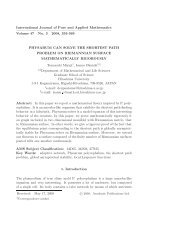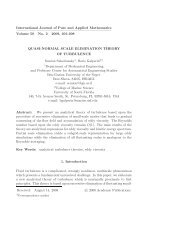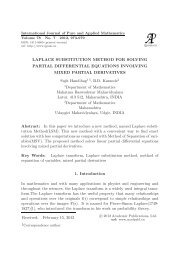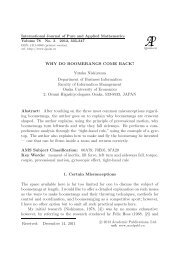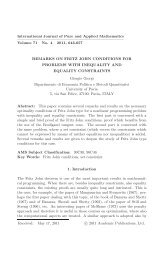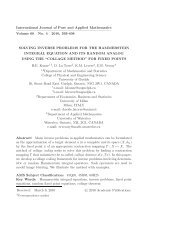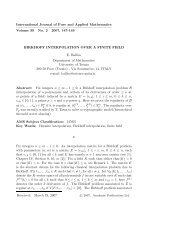download this paper (free) - International Journal of Pure and ...
download this paper (free) - International Journal of Pure and ...
download this paper (free) - International Journal of Pure and ...
You also want an ePaper? Increase the reach of your titles
YUMPU automatically turns print PDFs into web optimized ePapers that Google loves.
<strong>International</strong> <strong>Journal</strong> <strong>of</strong> <strong>Pure</strong> <strong>and</strong> Applied Mathematics<br />
Volume 79 No. 3 2012, 499-513<br />
ISSN: 1311-8080 (printed version)<br />
url: http://www.ijpam.eu<br />
A NON-CONTAGIOUS RANDOM SPREAD<br />
OF MARKETING MESSAGES<br />
Ely Merzbach 1 § , Jacques Picard 2<br />
1 Department <strong>of</strong> Mathematics<br />
Bar-Ilan University<br />
52900, Ramat-Gan, ISRAEL<br />
2 Netanya Academic College<br />
Israel <strong>and</strong> University <strong>of</strong> Quebec at Montreal<br />
CANADA<br />
PA<br />
ijpam.eu<br />
Abstract: In <strong>this</strong> <strong>paper</strong> we attempt to find a solution to the problem in the<br />
field <strong>of</strong> marketing communications <strong>of</strong> how to insure that a certain area will be<br />
sufficiently covered by the launching <strong>of</strong> items containing communication materials,<br />
when an immediate effect is required. It was found that it is possible<br />
to determine the necessary number <strong>of</strong> items for a given density <strong>of</strong> area coverage.<br />
The method comes from the theory <strong>of</strong> stochastic geometry <strong>and</strong> r<strong>and</strong>om<br />
tessellations. We give a mathematical formula based on two parameters; the<br />
first is the maximal distance between the resulting location <strong>of</strong> any launched<br />
item <strong>and</strong> any point on the area, <strong>and</strong> the second is the confidence probability.<br />
The model can be used in circumstances for which there exists an interest in<br />
communicating rapidly with a population segment located in a certain area in<br />
order to trigger immediate action.<br />
Key Words: Word-<strong>of</strong>-Mouth, advertising,<br />
1. Introduction<br />
One <strong>of</strong> the main preoccupations <strong>of</strong> marketers has always been to have their<br />
messages reach the target public. Lack <strong>of</strong> knowledge, underst<strong>and</strong>ing or favor-<br />
Received: June 12, 2012<br />
§ Correspondence author<br />
c○ 2012 Academic Publications, Ltd.<br />
url: www.acadpubl.eu
500 E. Merzbach, J. Picard<br />
able attitude toward their product means few sales, or little action (in case <strong>of</strong><br />
non-commercial marketing). Communication to a target public can go through<br />
primary sources (advertising, salespeople ...) or social sources, also called informal<br />
channels (word-<strong>of</strong>-mouth, network diffusion ...). In the modern context<br />
<strong>of</strong> mass markets, much <strong>of</strong> the communication between marketers <strong>and</strong> target<br />
audiences is being achieved through advertising. As a consequence, an early<br />
concern <strong>of</strong> mass marketers was to find the media plan that would maximize<br />
impact among target customers. Since the 1960’s (with the increasing use <strong>of</strong><br />
computers), much research has dealt with media planning. At the beginning,<br />
it was mainly based on linear programming or other basic models (Georges<br />
(2003), Zangwill (1965), Mevik et al. (1966), Bass et al, (1966), H<strong>of</strong>mans<br />
(1966), Stasch (1967), Brown (1967), Charnes et al. (1968), Gensch (1968)).<br />
In the 70’s, qualitative factors were incorporated into the various models (Gensch<br />
(1970), Scissors 1971), Kaplan et al. (1971), Catry et al. (1973), Mogg et<br />
al. (1974), Aaker 1975), Bogart (1975), Doyle et al. (1975), Loc<strong>and</strong>er et al.,<br />
(1978), Cannon et al. (1980), Hornik (1980), Simon et al. (1980). In the 80’s,<br />
improvements were proposed for existing models (Cannon et al. (1982), Zufryden<br />
(1982), Scissors (1983), Cannon (1984), Naples (1984), Cannon (1985),<br />
Leckenby et al. (1986), Rust et al. (1986)). Then simulations <strong>and</strong> non-linear<br />
models became popular, while further refinements <strong>of</strong> existing models were suggested<br />
(Cannon (1988), Danaher 1991, Farris 1991, Rathnam et al. (1992),<br />
Abe (1996), (1997), Ephron, (1998), Naik et al. (1998), Ephron et al. (2002),<br />
Cannon et al. (2002), Pilotta et al. (2004), Coulter et al. (2005), Vakratsas<br />
et al. (2005), Tellis et al. (2006)). By the late 1990’s Web Media Planning<br />
became a subject <strong>of</strong> interest for researchers (Leckenby et al. (1998), Cheong<br />
et al. (2010), Pergelova et al. (2010)). Also, the issue <strong>of</strong> the effectiveness <strong>of</strong><br />
specific media vehicles was then addressed (Prendergast et al. (1999), Taylor et<br />
al. (2006), Lancaster et al. (2008), Rubinson (2009), Wakolbinger et al. (2009),<br />
Collins et al. (2010), Newstead et al. (2010), Smith et al. (2010), Yim et al.<br />
(2010)).<br />
One <strong>of</strong> the characteristics <strong>of</strong> media planning models is that they are not<br />
limited to immediate effects. First, many <strong>of</strong> the media involved (billboards,<br />
news<strong>paper</strong>s,magazines...) providetotheinsertedmessagesacertainlifelength,<br />
<strong>and</strong> might trigger exposure for several hours, days or even weeks after having<br />
been placed. Second, there is <strong>of</strong>ten a cumulative effect over time. This is true<br />
for most media <strong>and</strong> is especially important when dealing with low involvement<br />
products. Thus, one sole advertisement will not always produce the desired<br />
effect. It is the repetition <strong>of</strong> exposures, <strong>and</strong> maybe the combined use <strong>of</strong> several<br />
media that will do the trick.
A NON-CONTAGIOUS RANDOM SPREAD... 501<br />
A great deal <strong>of</strong> research has also been done on the issue <strong>of</strong> social channels<br />
1 . Recent articles have attempted to better underst<strong>and</strong> the phenomenon<br />
(Hartmannet al. (2008), deMatos et al. (2008), Lam et al. (2009), Colli<strong>and</strong>er<br />
et al. (2011)). Much emphasis has also been put on the impact <strong>of</strong> Online<br />
Social Interaction (Awad et al. (2008), Chung et al. (2010), Daniasa et al.<br />
(2010), Kozinetz et al. (2010), Trusov et al. (2010), Chen et al. (2011)). The<br />
interaction between marketers’ communication efforts <strong>and</strong> social channels has<br />
also been the focus <strong>of</strong> investigation (Mason (2008), Villanueva et al. (2008),<br />
Bhagat et al. (2009), Godes et al. (2009), Trusov et al. (2009), Hensel et<br />
al. (2010), Li et al. (2011), Zubcsek et al. (2011). What characterizes social<br />
channels is their contagious nature. This means that the message a recipient<br />
is exposed to, will <strong>of</strong>ten be transmitted further by him to others, who themselves<br />
will transfer it further <strong>and</strong> so forth. There are however circumstances<br />
when marketers cannot rely on retransmission on the one h<strong>and</strong>, <strong>and</strong> want their<br />
communication to have an instant <strong>and</strong> immediate effect, on the other h<strong>and</strong>. In<br />
the non-commercial field, <strong>this</strong> could occur when it is crucial to signal something<br />
without delay to a population living in a certain area, for example in case<br />
<strong>of</strong> an approaching tsunami, tab water being suddenly polluted etc. In those<br />
circumstances, the use <strong>of</strong> flyers (preferably self-destructive) sent by airplanes<br />
or helicopters might be seriously considered. Such an air operation might also<br />
be useful in the commercial field to announce a special surprise promotional<br />
event, to promote a perfume through the launching from the air <strong>of</strong> small tabs<br />
with micro-encapsulated flavor. In such cases, the arising question is how many<br />
flyers or tabs should be launched in order to obtain certain coverage over a<br />
specific area.<br />
More specifically, the question could be posed in a more precise manner:<br />
How many flyers or tabs or coupons should be thrown over a certain area in<br />
order to make sure with X% likelihood (the probability p) that no point in the<br />
given area should be more than t meters away from the fallen item?<br />
This problem is related to the necessity <strong>of</strong> instantaneous effect <strong>of</strong> a communication<br />
in the absence <strong>of</strong> contagious possibility that does not seem to have<br />
been dealt with in previous research. The following model which is derived<br />
from the mathematical theory <strong>of</strong> stochastic geometry should contribute to its<br />
solution.<br />
The main idea is to develop the concept <strong>of</strong> r<strong>and</strong>om tessellations which are<br />
important models <strong>of</strong> stochastic geometry. They have been used in various<br />
fields <strong>of</strong> science <strong>and</strong> technology, e.g., in biology, forestry, <strong>and</strong> material sciences<br />
1 For a review <strong>of</strong> literature until 2008 on Word-<strong>of</strong>-Mouth Communication coming from the<br />
mathematical theory <strong>of</strong> stochastic geometry, see E. Merzbach <strong>and</strong> J. Picard (2009).
502 E. Merzbach, J. Picard<br />
(for further examples see Stoyan-Stoyan (1994), for a description <strong>of</strong> plane or<br />
spatial mosaic-like structures. However, it has not previously been used in the<br />
marketing sciences.<br />
Among the different kinds <strong>of</strong> r<strong>and</strong>om tessellations, the well-known Voronoi<br />
tessellation is a simple but nevertheless very useful model with seems to be<br />
suitable for modelling mosaic-like structures resulting from growth processes,<br />
for example, <strong>of</strong> crystals. Up to now the Voronoi tessellation with respect to<br />
a homogeneous Poisson point process (Poisson-Voronoi tessellation) has been<br />
investigated very extensively, see for example, Merzbach (1988), Stoyan-Stoyan<br />
(1994), <strong>and</strong> Stoyan-Kendall-Mecke (1987). The only parameter <strong>of</strong> <strong>this</strong> model<br />
is the intensity λ > 0, the mean number <strong>of</strong> points <strong>of</strong> the underling Poisson<br />
point process per unit area or volume, respectively. The knowledge from analytical<br />
calculations concerning <strong>this</strong> model is limited almost exclusively to mean<br />
values <strong>of</strong> geometric characteristics. In recent <strong>paper</strong>s, e.g., Lorz (1990) <strong>and</strong><br />
Muche (1993), analytical methods <strong>and</strong> numerical integration were combined<br />
in order to obtain higher moments <strong>and</strong> covariances or the chord length distribution.<br />
Alternatively, the distributions <strong>of</strong> geometric characteristics can be<br />
determined by Monte Carlo methods. Clearly, such simulations are very timeconsuming.<br />
Hinde <strong>and</strong> Miles 1980, performed large-scaled simulation studies <strong>of</strong><br />
the plane Poisson-Voronoi tesellation. A small-scale Monte Carolo study concerning<br />
the spatial Poisson-Voronoi tessellation were carried out by Quine <strong>and</strong><br />
Watson (1984) (2,500 cells) <strong>and</strong> probably others.<br />
2. The Mathematical Model<br />
The main idea is to use the concept <strong>of</strong> r<strong>and</strong>om tessellation from the theory<br />
<strong>of</strong> stochastic geometry. More precisely, we will use a special case <strong>of</strong> r<strong>and</strong>om<br />
tessellation called the Voronoi tessellation or Voronoi mosaic.<br />
In order to properly describe the notion <strong>of</strong> Voronoi mosaic, we need the<br />
concept <strong>of</strong> d-dimensional point process, <strong>and</strong> the simplest point process is the<br />
homogeneous Poisson point process (hereafter referred to as the Poisson process).<br />
It is characterized by the following properties: (see Merzbach (1988) <strong>and</strong><br />
references there).<br />
1) The r<strong>and</strong>om number <strong>of</strong> points in an arbitrary bounded region B in space<br />
is Poisson distributed with parameter λV(B), where λ > 0 <strong>and</strong> V(B)<br />
denotes the volume <strong>of</strong> B.<br />
2) The r<strong>and</strong>om numbers <strong>of</strong> points in arbitrary disjoint, bounded regions<br />
B1,...Bn, n = 2,3,..., are stochastically independent.
A NON-CONTAGIOUS RANDOM SPREAD... 503<br />
Theonly parameter involved in <strong>this</strong> model is one <strong>of</strong> scale, the so-called intensity<br />
λ, the mean number <strong>of</strong> points per unit volume.<br />
In order to simulate a Poisson process with parameter λ within a bounded<br />
region B, first we have to generate a pseudo-r<strong>and</strong>om number N, Poisson distributed<br />
with parameter λV(B), <strong>and</strong> secondly, to generate N independent<br />
points, identically uniformly distributed in B. (see Lorz (1990)).<br />
The homogeneous Poisson point process is sometimes called a completely<br />
r<strong>and</strong>om field.<br />
We can consider also a inhomogeneous Poisson process, where in property<br />
1) we replace λV(B) by an arbitrary intensity. For example, in the twodimensional<br />
space R 2 , the following intensities are frequently used:<br />
The intensity function<br />
λ(x,y) = λx, x > 0, y ∈ R<br />
λ(x,y) = λ(1+sin(x)), z,y ∈ R.<br />
λ(x,y) = λexp −(x 2 +y 2 ) , x,y ∈ R<br />
describes a point field, where the intensity function is symmetric <strong>and</strong> decreases<br />
with the distance from the centre.<br />
A Voronoi mosaic in the d-dimensional space, R d , is determined by a set<br />
φ ⊆ R d <strong>of</strong> points ξi, i = 1,2,... <strong>and</strong> the definition<br />
C(ξi) = {ξ ∈ R d : ξ −ξip < ξ −ξjp for all ξj = ξi,ξj ∈ φ}<br />
for the cell C(ξi) is assigned to the point ξi ∈ φ. The system <strong>of</strong> all cells forms<br />
the Voronoi mosaic.<br />
If we consider only a boundedregion <strong>of</strong> thespace, thenthe number<strong>of</strong> points<br />
ξi is generally finite.<br />
The norm used is the Lp-norm:<br />
where<br />
ξ =<br />
ξ −ξip =<br />
d <br />
ξ (k) (k) <br />
−ξ p1/p , p > 0<br />
k=1<br />
<br />
ξ (1) ,...,ξ (d)<br />
i<br />
<strong>and</strong> ξi =<br />
<br />
ξ (1)<br />
i ,...,ξ (d)<br />
<br />
i .<br />
Generally, p = 2 is the Euclidean norm.<br />
Let Ci(t) = C(ξi)∩B(ξi,t), where B(ξi,t) = {ξ ∈ R d : ξ−ξip < t} is the<br />
open ball centered at ξi <strong>and</strong> with radius t.
504 E. Merzbach, J. Picard<br />
Assuming the uniform distribution <strong>of</strong> falling points <strong>of</strong> the flyers, then the<br />
point field φ is completely r<strong>and</strong>om. Therefore, as a classical result, <strong>this</strong> point<br />
process can be considered as a homogeneous Poisson point field.<br />
The following figure (taken from Stoyan-Kendall-Mecke (1987)) shows an<br />
example <strong>of</strong> a Voronoi mosaic with respect to a homogeneous Poisson point field<br />
in the plane R 2 .<br />
grains.<br />
For any t ≥ 0, let Ψ(t) = ∞<br />
Ci(t). It is a Boolean model with spherical<br />
i=1<br />
The main result is the following.<br />
Theorem. For any point x ∈ R d , <strong>and</strong> any t > 0,<br />
P{x ∈ Ψ(t)} = 1−exp{−λvdt d }<br />
where λ is the intensity <strong>of</strong> the process <strong>and</strong> vd is the volume <strong>of</strong> the unit sphere<br />
<strong>of</strong> R d .<br />
A pro<strong>of</strong> <strong>of</strong> <strong>this</strong> result can be found in Muche (1993). Here we present a<br />
simplified pro<strong>of</strong>.<br />
Pro<strong>of</strong>. P{x /∈ Ψ(t)} is the probability that there are no points to a distance<br />
t from a point ξi. According to the Poisson distribution, <strong>this</strong> probability is<br />
equal to exp{−λvdt d } since the “volume function” is given by vdt d (see Stoyan-<br />
Kendall-Mecke (1987), p. 66). Then the result follows.<br />
Remark. The volume <strong>of</strong> the unit sphere must be computed in accordance<br />
with the metric (distance) used in the region. Theusual metric is the Euclidean
A NON-CONTAGIOUS RANDOM SPREAD... 505<br />
norm. However, in some cases, the distance needs to be computed differently,<br />
due to topographic or urban constraints, like rivers, mountains, houses, roads,<br />
stairs, etc.<br />
In the Euclidean norm v1 = 1, v2 = π <strong>and</strong> more generally<br />
vd = π d/2 <br />
d<br />
/Γ<br />
2 +1<br />
<br />
where Γ is the Gamma function:<br />
Γ(α) =<br />
∞<br />
x<br />
0<br />
α−1 e −x dx.<br />
Corollary. In the d-dimensional space, the intensity λ is given by:<br />
λ =<br />
ln(1−P{x ∈ Ψ(t)})<br />
−vdtd .<br />
For our purpose, the interesting case is the plane R2 , with the Euclidean<br />
norm. We then get<br />
ln(1−P{x ∈ Ψ(t)})<br />
λ = .<br />
−πt 2<br />
Consequently, it is possible to determine the number <strong>of</strong> flyers (λ multiplied<br />
by the surface <strong>of</strong> the region) required to cover a certain area, given the<br />
confidence probability <strong>and</strong> the radius <strong>of</strong> each zone <strong>of</strong> inference.<br />
3. Numerical Results<br />
As an illustration, the following table gives the number <strong>of</strong> flyers per area unit.<br />
p \ t 5 10 20<br />
0.80 0.020502 0.005125 0.001281<br />
0.90 0.029332 0.007333 0.001833<br />
0.95 0.038161 0.009540 0.002385<br />
0.99 0.058664 0.014666 0.003666<br />
Here p is the confidence probability <strong>and</strong> t is the radius <strong>of</strong> the influence flyer<br />
zone. For example, if t is measured in meters <strong>and</strong> the region is one kilometric<br />
square, then multiply the numbers in the table by 10 6 . If, for example, the<br />
confidence probability is chosen to be 0.80 (permitting an error <strong>of</strong> 20%), <strong>and</strong><br />
the flyer influence radius is 10 meters, we need 5125 flyers to cover the entire<br />
region.
506 E. Merzbach, J. Picard<br />
4. Some Extensions<br />
Our model can be generalized in several directions:<br />
1. Shape<strong>of</strong> the cells: The cells Ci(t) are not generated by balls. For different<br />
reasons the influence zone <strong>of</strong> a flyer is not a circle, but has another shape.<br />
2. Different times: Theflyers do not arrive at the same time. In <strong>this</strong> case, we<br />
have a dynamic r<strong>and</strong>om tessellation <strong>and</strong> we need to use vector stochastic<br />
processes.<br />
3. Growth rate: Each cell or each flyer has a different growth rate. In other<br />
words, the zone <strong>of</strong> influence is not the same for different objects. In <strong>this</strong><br />
case, we have to add a r<strong>and</strong>om growth coefficient <strong>and</strong> we get another kind<br />
<strong>of</strong> r<strong>and</strong>om tessellation.<br />
5. Conclusions<br />
This article has attempted to find a solution to a problem in the field <strong>of</strong> marketing<br />
communications that was not dealt previously, i.e., how to insure that<br />
a certain area will be sufficiently covered by the launching <strong>of</strong> items containing<br />
communication materials, when an immediate effect is required.<br />
It was found that it is possible to determine the necessary number <strong>of</strong> items<br />
for a given density <strong>of</strong> area coverage.<br />
It suffices to use a mathematical formula based on two parameters; one is<br />
the maximal distance between the resulting location <strong>of</strong> any launched item <strong>and</strong><br />
any point on the area, <strong>and</strong> the second is the confidence probability.<br />
The model can be used in circumstances for which there exists an interest<br />
in communicating rapidly with a population segment located in a certain area<br />
in order to trigger immediate action.<br />
References<br />
[1] D.A. Aaker, ADMOD: An Advertising Decision Model, <strong>Journal</strong> <strong>of</strong> Marketing<br />
Research 12, (1975), 37-45.<br />
[2] M. Abe, Audience Accumulation by Television Daypart Allocation Based<br />
on Household-Level Viewing Data, <strong>Journal</strong> <strong>of</strong> Advertising Research 25,<br />
No.4 (1996), 21-35.
A NON-CONTAGIOUS RANDOM SPREAD... 507<br />
[3] M. Abe, A Household-Level television Advertising exposure Model, <strong>Journal</strong><br />
<strong>of</strong> Marketing Research 34, No.3 (1997), 394-405.<br />
[4] N. Awad, A. Ragowsky, Establishing Trust in Electronic Commerce<br />
ThroughOnlineWord <strong>of</strong> Mouth: An Examination across Genders, <strong>Journal</strong><br />
<strong>of</strong> Management information Systems 24, No. 4 (2008), 101-121.<br />
[5] F.M. Bass, R.T. Lonsdale, An Exploration <strong>of</strong> Linear Programming in Media<br />
Selection, <strong>Journal</strong> <strong>of</strong> Marketing Research 3, No.2 (1966), 179-188.<br />
[6] P.S. Bhagat, A. Klein, V. Sharma, The Impact <strong>of</strong> New Media on Internet-<br />
Based Group Consumer Behavior, <strong>Journal</strong> <strong>of</strong> the Academy <strong>of</strong> Business &<br />
Economics 9, No. 3 (2009), 83-94.<br />
[7] L. Bogart, Media Models: A Reassessment, <strong>Journal</strong> <strong>of</strong> Advertising 4, No.2<br />
(1975), 28-30.<br />
[8] D.B Brown, A practical Procedure for Media Selection, <strong>Journal</strong> <strong>of</strong> Marketing<br />
Research 4, No. 3 (1967), 262-269.<br />
[9] H.M. Cannon, The “Naive” Approach to Demographics Media Selection,<br />
<strong>Journal</strong> <strong>of</strong> Advertising Research, 24, No. 3 (1984), 21-25.<br />
[10] H.M. Cannon, Evaluating the Pr<strong>of</strong>ile-Distance Approach to Media Selection,<br />
<strong>Journal</strong> <strong>of</strong> Advertising 14, No.1 (1985), 4-9.<br />
[11] H.M. Cannon, Evaluating the “Simulation” Approach to Media Selection,<br />
<strong>Journal</strong> <strong>of</strong> Advertising Research 28, No.1 (1988), 57-63.<br />
[12] H.M. Cannon, G. Linda, Beyond Media Imperative, <strong>Journal</strong> <strong>of</strong> Advertising<br />
Research 22, No.3 (1982), 31-37.<br />
[13] H.M. Cannon, J.D. Lockenby, A. Abernethy, Beyond Effective Frequency:<br />
Evaluating Media schedules Using Frequency Value Planning, <strong>Journal</strong> <strong>of</strong><br />
Advertising Research 42, No. 6 (2002), 33-47.<br />
[14] H.M. Cannon, M.G. Merz, A New Role for Psychographics in Media Selection,<br />
<strong>Journal</strong> <strong>of</strong> Advertising 9, No.2 (1980), 33-44.<br />
[15] B.R. Catry, M. Chevalier, The Evolution <strong>of</strong> French Media Models, <strong>Journal</strong><br />
<strong>of</strong> Advertising Research 13, No. 3 (1973), 19-26.<br />
[16] A. Charnes, W.W. Cooper, J.K. DeVoe, W. Reinecke, A Goal Programming<br />
for Media Planning, Management Science 14, No.8 (1968), 423-430.
508 E. Merzbach, J. Picard<br />
[17] Y. Chen, Q. Wang, J. Xie, Online Social Interactions: A Natural Experiment<br />
on Word <strong>of</strong> Mouth Versus Observational Learning, <strong>Journal</strong> <strong>of</strong><br />
Marketing Research 48, No. 2 (2011), 238-254.<br />
[18] Y. Cheong, F. deGregorio, K.Kim, The Power <strong>of</strong> Reach <strong>and</strong> Frequency in<br />
the Age <strong>of</strong> Digital advertising: Offline <strong>and</strong> Online Media Dem<strong>and</strong> Metrics,<br />
<strong>Journal</strong> <strong>of</strong> Advertising Research 50, No.4 (2010), 403-415.<br />
[19] C. Chung. K. Austria, Social Media Gratification <strong>and</strong> Attitude toward Social<br />
Media Marketing Messages: A study <strong>of</strong> the Effects <strong>of</strong> Social Media<br />
Marketing Messages on Online Shopping Value, Proceedings <strong>of</strong> the Northeast<br />
Business & Economics Association 2010, 581-586.<br />
[20] J. Colli<strong>and</strong>er, M. Dohlen, Following the Fashionable Friend, The Power <strong>of</strong><br />
Social Media, <strong>Journal</strong> <strong>of</strong> Advertising Research 51, No.1 (2011), 313-320.<br />
[21] J. Collins, D. Dixon, W. Eadie, M. Reggimenti, D. Schiffman, J.<br />
Soukhareva, J. Vogel, B. Britta, How More Precise Magazine Inputs Can<br />
Improve Media Mix Modeling, The Impact <strong>of</strong> More Balanced Metrics on<br />
ROI, <strong>Journal</strong> <strong>of</strong> Advertising Research 50, No. 1 (2010), 10-15.<br />
[22] P.J. Danaher, A Canonical Expansion Model for Multivariate Media Exposure<br />
Distribution: A Generalization <strong>of</strong> the “Duplication <strong>of</strong> Viewing Law”,<br />
<strong>Journal</strong> <strong>of</strong> Marketing Research 28, No.3 (1991), 361-367.<br />
[23] C. Daniasa, V. Tomita, D. Stuparu, M. Stanciu, The Mechanisms <strong>of</strong> the<br />
Influence <strong>of</strong> Viral Marketing in Social Media, Economics, Management, &<br />
Financial Markets 5, No. 3 (2010), 278-282.<br />
[24] D. Desmond, A. Alvin, R. Mizerski, The Effects <strong>of</strong> Cultural Values in<br />
Word-<strong>of</strong>-Mouth Communication, <strong>Journal</strong> <strong>of</strong> <strong>International</strong> Marketing 17,<br />
No. 3 (2009), 55-70.<br />
[25] P. Doyle, I. Fenwick, Planning <strong>and</strong> Estimation in Advertising, <strong>Journal</strong> <strong>of</strong><br />
Marketing Research 12, No. 1,(1975), 1-6.<br />
[26] E. Ephron, Point <strong>of</strong> View: Optimizers <strong>and</strong> Media Planning, <strong>Journal</strong> <strong>of</strong><br />
Advertising research 38, No. 4 (1998), 47- 56.<br />
[27] E. Ephron, C. McDonald, Media Scheduling <strong>and</strong> Carry-over-Effects: Is<br />
Adstock a Useful TV Planning Tool?, <strong>Journal</strong> <strong>of</strong> Advertising Research 42,<br />
No.2 (2002), 66-70.
A NON-CONTAGIOUS RANDOM SPREAD... 509<br />
[28] P.W. Farris, M.E. Parry, Clarifying some Ambiguities regarding GRP <strong>and</strong><br />
average Frequency: A comment on “GRP: A Case <strong>of</strong> Mistaken Identity”,<br />
<strong>Journal</strong> <strong>of</strong> Advertising Research 31, No.6 (1991), 75-77.<br />
[29] D.H. Gensch, Computer Models in Advertising Media Selection, <strong>Journal</strong><br />
<strong>of</strong> Marketing Research 5, No.4 (1968), 414-424.<br />
[30] D.H. Gensch, Media Factors: A Review Article, <strong>Journal</strong> <strong>of</strong> Marketing<br />
Research, 7, No.2 (1970), 216-225.<br />
[31] J.S. Georges, How Practical is the Media Model, <strong>Journal</strong> <strong>of</strong> Marketing, 27,<br />
No.3 (1963) 31-33.<br />
[32] G. Godes, D. Mayzlin, Firm-Created Word-<strong>of</strong>-Mouth Communication: Evidence<br />
from a Field Test, Marketing Science, 28, No.4 (2009), 721-739.<br />
[33] W. Hartmann, P. Manch<strong>and</strong>a, H. Nair, M. Bothner, P. Dodds, D. Godes,<br />
K. Hosanagar, C. Tucker, Modeling Social Interactions: Identification,<br />
Empirical Methods <strong>and</strong> Policy Implications, Marketing Letters 19, No.3-4<br />
(2008), 287-304.<br />
[34] K. Hensel, M.H. Deis, Using Social Media to Increase Advertising <strong>and</strong><br />
Improve Marketing, Entrepreneurial Executive 15, (2010), 87-97.<br />
[35] A.L. Hinde, R.E. Miles, Monte-Carlo Estimates <strong>of</strong> the Distributins <strong>of</strong> the<br />
R<strong>and</strong>om Polygons <strong>of</strong> the Voronoi Tessellations with respect to a Poisson<br />
Process, <strong>Journal</strong> <strong>of</strong> Statistical Computation <strong>and</strong> Simulations 10, (1980),<br />
205-223.<br />
[36] P. H<strong>of</strong>mans, Measuring the Cumulative Net Coverage <strong>of</strong> Any Combination<br />
<strong>of</strong> Media, <strong>Journal</strong> <strong>of</strong> Marketing Research 3, No.3 (1966) 269-278.<br />
[37] J.Hornik, MediaSubstitutability, <strong>Journal</strong> <strong>of</strong> Advertising Research20, No.2<br />
(1980), 33-42.<br />
[38] G. Ivan<strong>of</strong>f, E. Merzbach, A Martingale Characterization <strong>of</strong> the Set-indexed<br />
Poisson Process, Stochastics 51 (1994), 69-82.<br />
[39] R.S. Kaplan, A.D. Shocker, Discount Effects on Media Plans, <strong>Journal</strong> <strong>of</strong><br />
Advertising Research, 11, No. 3 (1971), 37-43.<br />
[40] R. Kozinets , K. de Valck, A.C. Wojnicki, S.J.S. Wilner, Networked Narratives:<br />
Underst<strong>and</strong>ing Word-<strong>of</strong>-Mouth Marketing in Online Communities,<br />
<strong>Journal</strong> <strong>of</strong> Marketing 74, No.2 (2010), 71-89.
510 E. Merzbach, J. Picard<br />
[41] D. Lam, A. Lee, R. Mizerski, The Effects <strong>of</strong> Cultural Values in Word<strong>of</strong>-Mouth<br />
Communication, <strong>Journal</strong> <strong>of</strong> <strong>International</strong> Marketing, 17, No.3<br />
(2009), 55-70.<br />
[42] K.M. Lancaster, A.R. Lancaster, Estimating Message Exposure Probability<br />
<strong>of</strong> Magazine Advertrising, American Academy <strong>of</strong> Advertising Conference<br />
Proceedings (2008), 317-317.<br />
[43] J.D. Leckenby, M.D. Rice, The Declining Reach Phenomenon in Exposure<br />
Distribution Models, <strong>Journal</strong> <strong>of</strong> Advertising 15, No.3 (1986), 13-20.<br />
[44] J.D. Leckenby, H. Jongpil, Using Reach/Frequency for Web Media Planning,<br />
<strong>Journal</strong> <strong>of</strong> Advertising Research 38, No.1 (1998), 7-20.<br />
[45] J. Li, L. Zhang, Online Persuasion: How the Written Word Drives WOM,<br />
<strong>Journal</strong> <strong>of</strong> Advertising Research 51, No.1 (2011), 239-357.<br />
[46] W.B. Loc<strong>and</strong>er, R.W. Scamell, R.M. Sparkman, J.P. Burton, Media Allocation<br />
Model Using Nonlinear Benefit Curves, <strong>Journal</strong> <strong>of</strong> Business Research<br />
6, No.4 (1978), 273-293.<br />
[47] U. Lorz, Cell-area distributions <strong>of</strong> planar sections <strong>of</strong> spatial Voronoi mosaics,<br />
Materials Characterization 25 (1990), 297-309.<br />
[48] R.B. Mason, Word <strong>of</strong> Mouth as a Promotional Tool for Turbulent Markets,<br />
<strong>Journal</strong> <strong>of</strong> Marketing Communications 14, No.3 (2008), 207-224.<br />
[49] C.A. de Matos, C.A.V. Rossi, Word-<strong>of</strong>-mouth Communications in Marketing:<br />
A Meta-analytical Review <strong>of</strong> Antecedents <strong>and</strong> Moderators, <strong>Journal</strong> <strong>of</strong><br />
the Academy <strong>of</strong> Marketing Science 36, No.4 (2008), 578-596.<br />
[50] F. Mercier <strong>and</strong> O. Baujard, Voronoi diagrams to model forest dynamics in<br />
French Guiana, Proc. 2nd Int’l Conf. on GeoComputation, Proceedings <strong>of</strong><br />
the 2rd <strong>International</strong> Conference on GeoComputation (1997), 161-171.<br />
[51] E. Merzbach, Point processes in the plane, Acta Applic. Math. 12 (1988),<br />
79-101.<br />
[52] E. Merzbach <strong>and</strong> J. Picard, Multi-step “Word-<strong>of</strong>-Mouth” Communication<br />
Influence in Marketing: A Mathematical Model, <strong>International</strong> <strong>Journal</strong> <strong>of</strong><br />
<strong>Pure</strong> <strong>and</strong> Applied Mathematics 54, No.4 (2009), 503-519.<br />
[53] O.B. Mevik, N.Vinding, Two Dimensions <strong>of</strong> Media Selection: Coverage<br />
<strong>and</strong> Frequency, <strong>Journal</strong> <strong>of</strong> Advertising Research 6, No. 1 (1966), 29-34.
A NON-CONTAGIOUS RANDOM SPREAD... 511<br />
[54] J.M. Mogg, B.M. Enis, Assessing Media Effectiveness via Network Flowgraphs,<br />
<strong>Journal</strong> <strong>of</strong> Advertising 3, No. 3 (1974), 35-41R.<br />
[55] J. Moller, Lectures on R<strong>and</strong>om Voronoi Tessellations, Lect. Notes in Stat.,<br />
Springer Verlag, 1994.<br />
[56] L. Muche, An incomplete Voronoi Tessellation, Appl. Math. 22, No.1<br />
(1993), 45-53.<br />
[57] P. A. Naik, M.K. Mantrala, A.G. Sawyer, Planning Media Schedules in<br />
the Presence <strong>of</strong> Dynamic Advertising Quality, Marketing Science 17, No.3<br />
(1998), 214-235.<br />
[58] M.J. Naples, Electronic Media Research: an Update <strong>and</strong> Look at the Future,<br />
<strong>Journal</strong> <strong>of</strong> Advertising Research 24, No.4 (1984), 39-48.<br />
[59] K. Newstead, J. Romaniuk, Cost per Second the Relative Effectiveness<br />
<strong>of</strong> 15- <strong>and</strong> 30- Second Television Advertisements, <strong>Journal</strong> <strong>of</strong> Advertising<br />
Research 50, No.1 (2010), 68-76.<br />
[60] A. Okabe, B. Boots <strong>and</strong> K. Sugihara, Spatial Tessellations, Concepts <strong>and</strong><br />
Applications <strong>of</strong> Voronoi Diagrams, Wiley, Chichester, 1992.<br />
[61] A. Pergelova, D. Prior, J. Rialp, Assessing Advertising Efficiency, <strong>Journal</strong><br />
<strong>of</strong> Advertising 39, No.3 (2010), 39-54.<br />
[62] J.J. Pilotta, D.E. Schultz, G. Drenik, P. Rist, Simultaneous Media Usage:<br />
A Critical Consumer Orientation to Media Planning, <strong>Journal</strong> <strong>of</strong> Consumer<br />
Behaviour 3, No.3 (2004), 285-292.<br />
[63] G. Prendergast, C.C. Hang, The Effectiveness <strong>of</strong> Exterior Bus Advertising:<br />
APreliminaryInvestigation, <strong>Journal</strong> <strong>of</strong> <strong>International</strong> Consumer Marketing<br />
11, No.3 (1999), 33-50.<br />
[64] M.P. Quine, D.F. Watson, Radial Generation <strong>of</strong> n-dimensional Poisson<br />
Processes, <strong>Journal</strong> <strong>of</strong> Applied Probability 21, (1984), No.3 (1984), 348-557.<br />
[65] S. Rathnam, M.R. Arun, A. Chaudhury, P.R. Shukla, MUDRAPLAN-A<br />
DDS for Media Planning: From Design to Utilization,Interfaces 22, No.2<br />
(1992), 65-75.<br />
[66] J. Rubinson, Empirical Evidence <strong>of</strong> TV Advertising Effectiveness, <strong>Journal</strong><br />
<strong>of</strong> Advertising Research 49, No.2 (2009), 220-226.
512 E. Merzbach, J. Picard<br />
[67] R.T.Rust, M.R. Zimmer, R.P. Leone, EstimatingtheDuplicated Audience<br />
<strong>of</strong> Media Vehicles in National Advertising Schedules, <strong>Journal</strong> <strong>of</strong> Advertising<br />
15, No.3 (1986), 30-37.<br />
[68] J. Schreiber, A Practical Procedure for Media Selection: Comments, <strong>Journal</strong><br />
<strong>of</strong> Marketing Research 5, No.2 (1968), 221-222<br />
[69] J.Z. Scissors, Matching Media with Markets, <strong>Journal</strong> <strong>of</strong> Advertising Research<br />
11, No. 5 (1971), 39-43.<br />
[70] J.Z. Scissors, Confusionsabout Effective Frequency, <strong>Journal</strong> <strong>of</strong> Advertising<br />
Research 22, No.6 (1983), 33-37.<br />
[71] H. Simon, M. Thiel, Hits <strong>and</strong> Flops among German Media models, <strong>Journal</strong><br />
<strong>of</strong> Advertising Research 20, No.6 (1980), 25-30.<br />
[72] J.A.Smith, B.A. Boyle, H.M. Cannon, Survey-BasedTargetingFine-Tunes<br />
Television Media Planning, <strong>Journal</strong> <strong>of</strong> Advertising Research 50, No.4,<br />
(2010), 428-439.<br />
[73] S.F. Stasch, Linear Programming <strong>and</strong> Space-Time in Media Selection,<br />
<strong>Journal</strong> <strong>of</strong> Advertising Research 5, No.4 (1968),40-46.<br />
[74] D. Stoyan, W.S. Kendall <strong>and</strong> J. Mecke, Stochastic Geometry <strong>and</strong> its Applications,<br />
Berlin, Akademic-Verlag, 1987.<br />
[75] D. Stoyan <strong>and</strong> H. Stoyan, Fractals, R<strong>and</strong>om Shapes <strong>and</strong> Point Fields, J.<br />
Wiley & Sons, 1994.<br />
[76] C.Taylor, G.R.Franke, B.Hae-Kyong, Use<strong>and</strong>Effectiveness <strong>of</strong>Billboards,<br />
<strong>Journal</strong> <strong>of</strong> Advertising 35, No. 4 (2006), 21-34.<br />
[77] G.J. Tellis, P.H. Franses, Optimal Interval data for Estimating Advertising<br />
Response, Marketing Science, 25, No.3 (2006), 217-229.<br />
[78] M. Trusov, R.E. Bucklin, K. Pauwels, Effects <strong>of</strong> Word-<strong>of</strong> Mouth Versus<br />
Traditional Marketing: Finding from an Internet Social Networking Site,<br />
<strong>Journal</strong> <strong>of</strong> Marketing 73, No. 5 (2009) 90-102.<br />
[79] M. Trusov, R.E. Bucklin, K. Pauwels, Monetary Value Of Word-<strong>of</strong>-Mouth<br />
Marketing in Online Communities, GfK- Marketing Intelligence Review 2,<br />
No. 1 (2010), 26-33.
A NON-CONTAGIOUS RANDOM SPREAD... 513<br />
[80] D. Vakratsas, M. Zhenfeng, A Look at the Long-run Effectiveness <strong>of</strong> Media<br />
Advertising <strong>and</strong> its Implcations for Budget Allocation Decisions, <strong>Journal</strong><br />
<strong>of</strong> Advertising Research 45, No.2 (2005), 241-254.<br />
[81] J. Villanueva, S.Yoo, D.M. Hanssens, The Impact <strong>of</strong> Marketing-Induced<br />
Versus Word-<strong>of</strong>-Mouth Customer Acquisition on Customer Growth, <strong>Journal</strong><br />
<strong>of</strong> Marketing Research 45, (2008), 48-58.<br />
[82] L. Wakolbinger, M. Denk, K. Oberecker, The Effectiveness <strong>of</strong> Combining<br />
Online <strong>and</strong> Print Advertising, <strong>Journal</strong> <strong>of</strong> Advertising Research 49, No.3<br />
(2009), 360-372.<br />
[83] M.Y. Yim, S. Yoo, B.D. Till, M.S. Eastin, In Store Video Advertising<br />
Effectiveness, <strong>Journal</strong> <strong>of</strong> Advertising Research 50, No.4 (2010), 386-402.<br />
[84] W.I. Zangwill, Media Selection by Decision Programming, <strong>Journal</strong> <strong>of</strong> Advertising<br />
Research 5, No.3 (1965), 30-36.<br />
[85] P. Zubczek, M. Sarvary, Advertising to a Social Network, Quantitative<br />
Marketing & Economics 9, No.1 (2011), 71-107.<br />
[86] .S. Zufryden, Predicting Trial Repeat <strong>and</strong> Sales Response from Alternative<br />
Media Plans, <strong>Journal</strong> <strong>of</strong> Advertising Research 22, No.3 (1982), 45-53.
514



